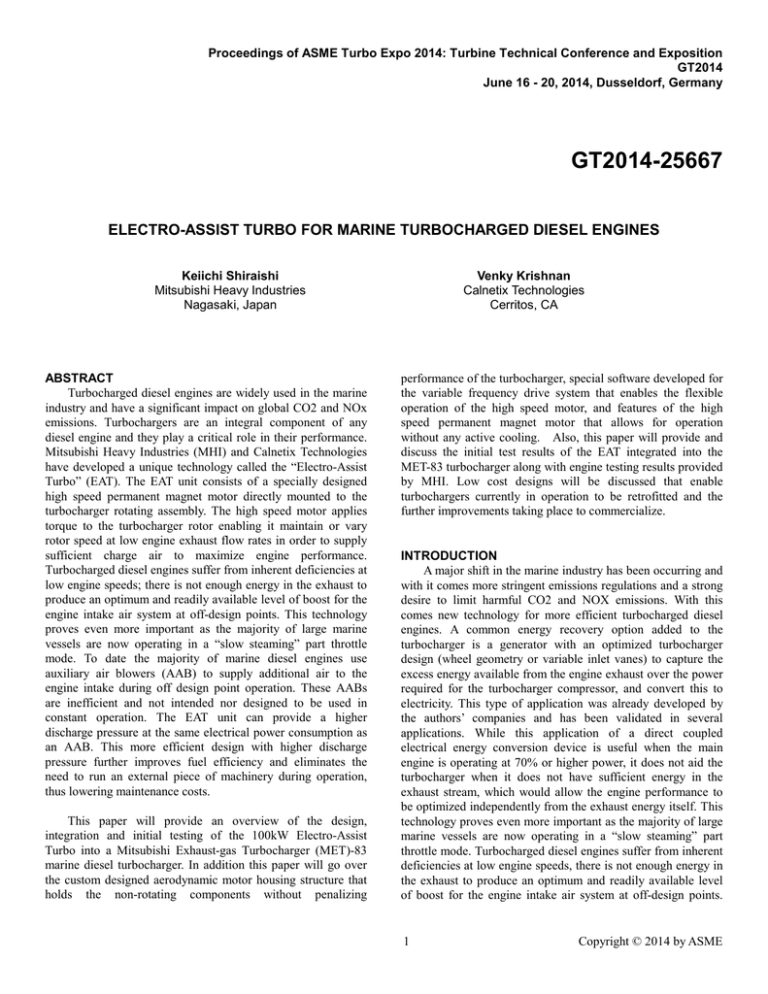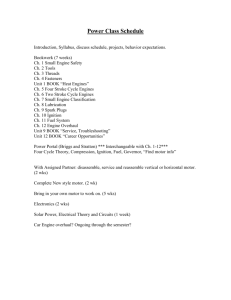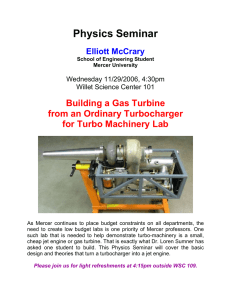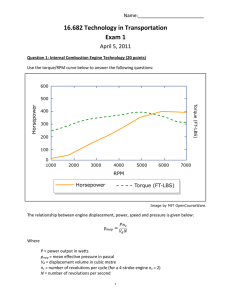Proceedings of ASME Turbo Expo 2014: Turbine Technical Conference and... GT2014 June 16 - 20, 2014, Dusseldorf, Germany
advertisement

Proceedings of ASME Turbo Expo 2014: Turbine Technical Conference and Exposition GT2014 June 16 - 20, 2014, Dusseldorf, Germany GT2014-25667 ELECTRO-ASSIST TURBO FOR MARINE TURBOCHARGED DIESEL ENGINES Keiichi Shiraishi Mitsubishi Heavy Industries Nagasaki, Japan ABSTRACT Turbocharged diesel engines are widely used in the marine industry and have a significant impact on global CO2 and NOx emissions. Turbochargers are an integral component of any diesel engine and they play a critical role in their performance. Mitsubishi Heavy Industries (MHI) and Calnetix Technologies have developed a unique technology called the “Electro-Assist Turbo” (EAT). The EAT unit consists of a specially designed high speed permanent magnet motor directly mounted to the turbocharger rotating assembly. The high speed motor applies torque to the turbocharger rotor enabling it maintain or vary rotor speed at low engine exhaust flow rates in order to supply sufficient charge air to maximize engine performance. Turbocharged diesel engines suffer from inherent deficiencies at low engine speeds; there is not enough energy in the exhaust to produce an optimum and readily available level of boost for the engine intake air system at off-design points. This technology proves even more important as the majority of large marine vessels are now operating in a “slow steaming” part throttle mode. To date the majority of marine diesel engines use auxiliary air blowers (AAB) to supply additional air to the engine intake during off design point operation. These AABs are inefficient and not intended nor designed to be used in constant operation. The EAT unit can provide a higher discharge pressure at the same electrical power consumption as an AAB. This more efficient design with higher discharge pressure further improves fuel efficiency and eliminates the need to run an external piece of machinery during operation, thus lowering maintenance costs. This paper will provide an overview of the design, integration and initial testing of the 100kW Electro-Assist Turbo into a Mitsubishi Exhaust-gas Turbocharger (MET)-83 marine diesel turbocharger. In addition this paper will go over the custom designed aerodynamic motor housing structure that holds the non-rotating components without penalizing Venky Krishnan Calnetix Technologies Cerritos, CA performance of the turbocharger, special software developed for the variable frequency drive system that enables the flexible operation of the high speed motor, and features of the high speed permanent magnet motor that allows for operation without any active cooling. Also, this paper will provide and discuss the initial test results of the EAT integrated into the MET-83 turbocharger along with engine testing results provided by MHI. Low cost designs will be discussed that enable turbochargers currently in operation to be retrofitted and the further improvements taking place to commercialize. INTRODUCTION A major shift in the marine industry has been occurring and with it comes more stringent emissions regulations and a strong desire to limit harmful CO2 and NOX emissions. With this comes new technology for more efficient turbocharged diesel engines. A common energy recovery option added to the turbocharger is a generator with an optimized turbocharger design (wheel geometry or variable inlet vanes) to capture the excess energy available from the engine exhaust over the power required for the turbocharger compressor, and convert this to electricity. This type of application was already developed by the authors’ companies and has been validated in several applications. While this application of a direct coupled electrical energy conversion device is useful when the main engine is operating at 70% or higher power, it does not aid the turbocharger when it does not have sufficient energy in the exhaust stream, which would allow the engine performance to be optimized independently from the exhaust energy itself. This technology proves even more important as the majority of large marine vessels are now operating in a “slow steaming” part throttle mode. Turbocharged diesel engines suffer from inherent deficiencies at low engine speeds, there is not enough energy in the exhaust to produce an optimum and readily available level of boost for the engine intake air system at off-design points. 1 Copyright © 2014 by ASME With the varying operating conditions that marine diesels are put to use these days, the importance of having a turbocharger operation decoupled from the Main Engine can have significant benefits. this were mitigated early in the program with a dummy test rotor on the turbocharger (Figure 2). Rotor shaft vibration measurements made by MHI shown in Figure 3 indicated that there was no unstable amplitude and this was a feasible solution. To date the majority of marine diesel engines use auxiliary air blowers (AAB) to supply additional air to the engine intake during off design point operation. These AABs are inefficient and not intended nor designed to be used in constant operation. In addition, as the results of testing show, the efficiencies obtained from these AABs are significantly lower when compared to the solution offered in the paper. Mitsubishi Heavy Industries (MHI) and Calnetix Technologies have developed a unique technology called the “Electro-Assist Turbo” (EAT). The EAT unit consists of a specially designed high speed permanent magnet motor directly mounted to the turbocharger rotating assembly. The high speed motor applies torque to the turbocharger rotor enabling it to maintain or vary rotor speed at low engine exhaust flow rates in order to supply sufficient charge air to maximize engine performance. While not discussed in detail in this paper, the EAT also provides output power to the ship when excess energy is available from the turbine. FIGURE 2. DUMMY ROTOR VIBRATION MEASUREMENT TEST SYSTEM DESIGN The intent of this development was to provide a cost effective, simple and unencumbered solution for this application. The guiding principles were: a. Direct drive motor – no gears or auxiliary equipment b. Simple integration – no additional structures, easily retrofittable c. Low inlet profile – should not interfere with the air flow path to the compressor d. Unparasitic addition – no load losses to be minimized to keep the parasitic rotational losses to a minimum e. Simple electronics – small footprint and installation requirements A general arrangement of the EAT system is shown in Figure 1. FIGURE 3. CAMPBELL DIAGRAM OF MEASURED TURBOCHARGER ROTOR SHAFT VIBRATION The second major challenge to the design team was to profile the machine aerodynamically into the flowpath. The machine envelope was optimized by a set of analytical iterations on the turbocharger side by MHI. Working iteratively, a design envelope for the machine was achieved that met the requirements. Motor Construction FIGURE 1. GENERAL ARRANGEMENT Motor Design Considerations Due to the stringent requirements of the air flow path to the compressor, it was determined that a direct mount bearingless motor would be ideal. The rotordynamic risks associated with The motor itself is based on Calnetix field proven high speed permanent magnet technology. The main challenges addressed in the design of the EAT machine were: a. Power optimization b. Thermal management c. Controls optimization at the system level A six pole permanent magnet synchronous machine (PMSM) design was adopted to optimize the size of the 2 Copyright © 2014 by ASME machine for the overhung configuration, keeping the motor drive capability and loss management in the machine as key design factors. The machine stator uses high performance steel laminations and windings with a high temperature class 200 inverter grade insulation system. Since the design intent was to use the compressor inlet suction air flow around the machine to cool the motor, the stator was specially profiled to induce even air flow around the outside of the stator and the end-turns. A special encapsulation with high thermal conductivity was adopted in the winding system to enable heat extraction to the outer surface area in contact with the inlet air flow. Special consideration was given in the design to enable stator insertion into an installed turbocharger by having a sleeve over the stator that could be inserted from the air filter and silencer end of the turbocharger without significant disassembly. The stator assembly itself was centered and secured by a special finned housing arrangement designed by MHI that served the purpose of a. Structural mounting b. Centering c. Thermal conductance to the airflow The rotor design presented a separate and interesting problem. Typical designs of high speed machines require forced air flow through the rotor air gap to take away harmonic induced losses in the permanent magnet rotor. To enable the machine to operate without forced air in the rotor air gap, the rotor was specially constructed of a hollow magnetic steel shaft with a flanged connection to the turbocharger shaft. The use of Calnetix high temperature proprietary composite fiber retention system for the surface mounted magnets enable a low loss rotor construction, resulting in rotor magnetic losses less than 300W. The hollow inner diameter of the rotor was profiled and designed so as to create a suction path through the rotor center and the air gap. The natural flow created by the design enabled adequate rotor cooling for the application without the need for a forced airflow. FIGURE 5. 100 KW EAT CROSS-SECTION System Integration A minor modification on the turbocharger compressor impeller end and impeller shroud housing was made to have threaded holes to mount the rotor or driving shaft and stator support. The stator was supported by four stays arranged in tangential direction to avoid thermal stress on them. Optimum design of the support is still under study to minimize pressure losses before compressor impeller inlet. Power cables are taken out through a center hole in the air intake silencer (Figure 6). These modifications on the standard turbocharger do not change outline dimension or interface to the engine except power cables and leads from sensors, and no additional piping work is required to have EAT hardware. General arrangement and a profile of the EAT motor are shown in Figures 4 and 5. FIGURE 4. 100 KW EAT MOTOR PROFILE FIGURE 6. SYSTEM INTEGRATION 3 Copyright © 2014 by ASME System Control A key element of the EAT design are the controls and the motor drive. The EAT system functions in tandem with the turbine and engine control system to deliver the optimal power for the system operating point. The variable speed drive (VSD) is a bidirectional power electronic system that is designed by Calnetix for operation with the high speed PMSM. It has a low total harmonic distortion (THD) and meets IEEE 519 interconnect standards without the need for additional filters. The IGBT-based bidirectional configuration of the drive enables power regeneration if the application so demands. The VSD is a sensorless space vector modulated control system. One of the first verifications carried out for the system was to start up the turbocharger system from zero speed. The controls were verified to be capable of overcoming the striction torques without slip at the low speeds where the rotor position estimation is not available to close the speed control loop. In addition, it is necessary for the EAT system to “catch a spinning load” when commanded to kick in the electro-assist operation. This was validated at various speeds from 2000 rpm upwards. Two possible control options were considered for the system, with both presented here. As part of the system testing and controls optimization, one or a modification of the other could be adopted. System Testing Mitsubishi MET83MA type turbocharger with EAT was tested on a test bed. Start-up. At first, startup test was conducted. Electric power was supplied to the VSD to start the turbocharger rotor turning. The driving torque was enough to start the turbocharger rotor of 580kg from stand still condition. Since the EA motor system is sensorless and the power of the EA motor is small compared to the acceleration requirements of the large inertia of the rotating mass of the compressor and the turbine, this presented special challenges to the start-up. The start-up has to be necessarily open loop as the back emf of the machine is too low to be able to estimate accurately the rotor position until about 500 rpm. It is undesirable to have mis-starts where the stator flux filed is rotating but the actual rotor is not, as can happen when the stator field slew rate is too fast to pull away the rotating mass effectively due to the open loop control. Several small adaptations of the strategy in the VSD controls were required to ensure effective start up the turbocharger from rest each time. The optimal start-up torque and frequency slew rate were attained by repeated trials. A typical start waveform is shown in Figure 9 below. Control Option 1 (Figure 7) – This is a closed loop control configuration where the VSD controls are embedded in the Engine-Turbocharger Plant control loop. Since the VSD control bandwidth is much larger than that of the plant control loop, the system can be stable in the steady state while the VSD power output may oscillate. The drawback of this is that the plant control and the VSD speed control could interact in an undesirable manner in operation. One possible compromise is to reduce the VSD loop gains and accept a slower response to changes around a steady state setpoint. PLC Current Ref PI Speed Ref PI DSP-REG Current limit set point Speed FB Internal Inverter M T/C T/C Control Speed Command Current Feedback Internal PLC VSD FIGURE 7. CONTROL OPTION 1 FIGURE 9. START-UP WAVEFORMS A quasi open loop control with greater sophistication is considered in Option 2 (Figure 8). PE- PLC provides speed reference and ramp up time for the reference PLC Current Ref PI Speed Ref PI DSP-REG Current limit set point Speed FB Internal Inverter M T/C T/C COntrol Speed Command Current Feedback Internal PLC VSD FIGURE 8. CONTROL OPTION 2 While the controls appear to be open loop, the actual loop is closed at the engine control system level where the speed reference for the VSD control loop is an upper limit speed bound within which the VSD is allowed to pump power into the EAT system. Both options will be evaluated during testing. A strategy of applying a DC pulse at start-up to align the rotor to a known position was adopted. For a six pole motor, this resolves to a maximum start-up move of the rotor in the backwards direction of 60 deg. Since the turbocharger bearings and seals are bidirectional this did not pose a problem. However, it is important to make consideration for the effects of reverse rotation in the design and start-up strategy. The use of a resolver to obtain shaft position information can obviate this, but adds considerable complexity to the system, especially if the resolver signal is to be transmitted a considerable distance between the motor and the VSD ( as this will depend greatly on the actual location of the system components, especially if one takes into account retrofits). Once the rotating assembly is above 500 rpm, the rotor position estimation algorithm of the VSD captures the rotating 4 Copyright © 2014 by ASME mass in synchronism effectively. Several test repetitions of the final strategy confirmed the system parameter settings for effective start-up. instrumentation to capture the air flow velocity at the inlet and outlet locations of the motor flowpath as shown in the Figure 12 below. Catch-Spin. Another key control aspect of the system is the requirement to catch-spin the rotating mass at any speed within the operating range. Due to the varying operating condition of the main engine, and consequently the turbocharger, it is necessary for the EA system to disengage and engage the rotating system by being able to catch the rotating system and apply torque in synchronism. The VSD control system is ideally suited for this purpose. As long as the control is in closed loop, the rotor estimation algorithm and the PID controllers of the speed and current loop in the VSD were able to catch spin the rotating load within a margin of 2%. A representative waveform of the catch spin at 5000 rpm is attached below in Figure 10. FIGURE 12. AIR FLOW (VELOCITY)MEASUREMENT Once started up electrically, the turbine was fed with test stand gas and accelerated to the test speeds. At various speeds from 3000 to 7600 rpm, the gas inlet and the motor electrical input power to the EAT system were adjusted to simulate the engine operating conditions, while the compressor outlet pressure was monitored. This was used to generate a map of operation of the EAT system over the desired speed range and evaluate the performance of the EAT motor, the turbocharger and the effective main engine condition for each test point. FIGURE 10. CATCH-SPIN WAVEFORMS Performance Test Setup and Method. The EAT system electrical performance tests were conducted on a turbocharger test stand. The test setup is shown in Figure 11 below. Compressed air Pressure Gas Inlet (ME exhaust) Motor Performance. The motor system electrical performance was satisfactory and exceeded the designed power and thermal performance. The overall system efficiency was also better than the use of auxiliary blowers. A series of performance parameters – torque, stator temperature, and airflow across the motor are presented in the Figures 13,14 and 15 below. EA VSD Data Acquisition FIGURE 11. TEST SET-UP One of the key concerns was the ability of the natural flow of air across the EAT motor in the inlet profile of the compressor to be able to cool the motor with the special design. To assess this, the instrumented motor temperature was measured at several operating speeds and torques, with special FIGURE 13. TORQUE APPLIED VS SPEED 5 Copyright © 2014 by ASME FIGURE 14. STATOR TEMPERATURES FIGURE 17. EAT SYSTEM MAP (POST TEST) FIGURE 15. COOLING AIR FLOW System Efficiency and Engine Requirements. The overall system efficiency met or exceeded the design requirements at the test points. A comparison of the efficiency of the EAT system compared to the auxiliary blower is made in the succeeding sections. On a practical two stroke engine, the AAB is running to assist turbocharger when the engine output is 40% load or lower and scavenging air pressure is around 1.98 bar abs. If there is no assist by the AAB, scavenging air pressure may drop to 1.91 bar which is not acceptable for the engine. The AAB consumes 86kW to boost the pressure in this condition; however, the EAT can accelerate the turbocharger to deliver the same air pressure with power take-in of 60kW as shown in Figure 18. FIGURE 16. EAT SYSTEM EFFIEIENCY The EAT system was able to meet most of the requirements for engine performance as seen on the next figure below (Figure 17), delivering the equivalent scavenge air pressure of the existing system (red dots in the figure). However, there is a desire to have a higher scavenge air pressure (0.05 bar more). The desired powers are indicated in the figure (blue triangles), as a result of the system testing. These are intended to be addressed in the design of the EAT system in the next iteration, along with representative tests on an engine stand to measure engine emissions as well. FIGURE 18. INCREASE OF DISCHARGE AIR PRESSURE 6 Copyright © 2014 by ASME The effect of the EAT on an engine was confirmed by running engine tests with a MET83MBG hybrid turbocharger [1]. The turbocharger was developed to convert part of turbocharger shaft power to electric power, and it can supply all electric power demand on board. The result is shown in Figure 19. The broken line shows the power consumption of the AAB on the engine, and solid blue line shows power to the EAT to achieve the same scavenging air pressure as the AAB. Power to the EAT is about 23kW lower than the AAB at the engine output of 40% load. On the other hand, EAT enables the engine to run at any load and therefore the engine load profile can be like Figure 21 below, which is the same average speed with the AAB but with 1% lower fuel oil consumption . FIGURE 21. POSSIBLE ENGINE LOAD PROFILE WITH EAT TO HAVE THE SAME AVERAGE SPEED FIGURE 19. POWER CONSUMPTION ON THE ENGINE Benefit of EAT on commercial vessels Most commercial vessels are running slow steaming with the AAB running. AAB is automatically started and stopped depending on the engine scavenging air pressure or engine load. Generally AAB start and stop take place in the load range between 25 – 35% load, in order to avoid frequent start and stop of AAB which may reduce operating life. This can reduce not only vessel operational flexibility but also fuel efficiency. Figure 20 is an example of main engine operational load profile of a large container vessel. Operating hours at engine load of 21 – 30% load is low due to above reason. CONCLUSION An EAT system for Mitsubishi Heavy Industries large turbochargers has been developed. Motor rotor and stator were designed to be compact enough to integrate in the turbocharger without changing external dimension and interfaces to the engine. Test results show that EAT for marine two stroke diesel engine turbocharger can reduce electric power consumption on board when the ship is running at low load. The system performance was as expected in the design, and the controls for the start-up, catch-spin and the torque control loops were validated through testing. A sensorless control of the electro assist system has been demonstrated meeting the necessary aero performance and the efficiencies. ACKNOWLEDGMENTS Authors would like to express special thanks to Hitachi Zosen Corporation for their cooperation on the engine testing with our turbocharger. REFERENCES [1] K. Shiraishi, et. al. “Development of Large Marine Turbocharger for Generating Electric Power with Exhaust Gas from the Main Engine”, Mitsubishi Heavy Industries Technical Review Vol.47 No.3 (September 2010) FIGURE 20. AN EXAMPLE OF ENGINE LOAD PROFILE WITH AAB 7 Copyright © 2014 by ASME ANNEX A 8 Copyright © 2014 by ASME


